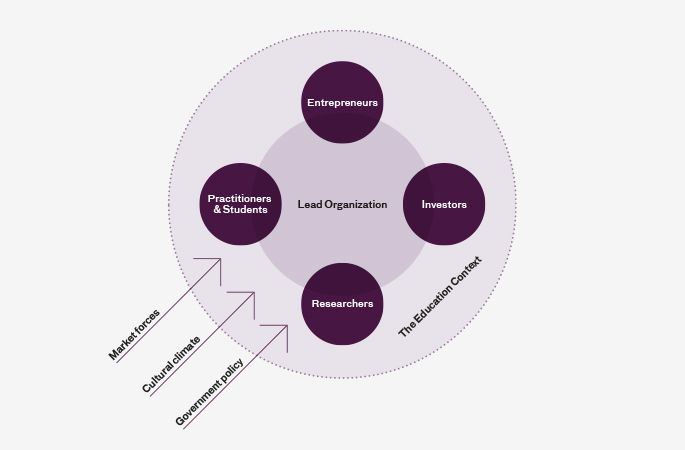
Innovation Ecosystems: Can we Scale What We’ve Learned?
In the University setting, an innovation ecosystem refers to the collaborative efforts of key stakeholders—including students, practitioners, entrepreneurs, investors, and researchers—to develop, adopt, and scale new processes, products, and services intended to improve teaching and learning. This paper, adapted from a larger research study, reflects on the application of theory to practice specifically in relation to the introduction of new technologies and the development of new ventures.
The late 20th-century shift toward a knowledge economy laid the groundwork for the emergence of greater interaction among universities, industry, and the government, with the effect that “universities and industry, up to now relatively separate and distinct institutional spheres, [were] each assuming tasks that were formerly largely the province of the other” (Etzkowitz & Leydesdorff, 1997, p. 2). Universities began to take on business and governance functions, while industry began to do research and to conduct training (education) in addition to providing its traditional goods and services. Government, previously responsible only for supplying the operating rules of the game, began providing capital for the launch of new ventures. This blurring of lines between university, government, and industry forms the basis of the triple helix model (Etzkowitz, 2008; Etzkowitz & Leydesdorff, 1997; Ranga & Etzkowitz, 2013).
The relationships and activities among university, government, and industry include, but are not limited to, collaboration, conflict moderation, collaborative leadership, networking, and substitution of functions across the three domains. Generally speaking, the triple helix seeks to generate knowledge, support innovative and/or entrepreneurial activity, and evaluate and advance new ideas.
As the three separate functions of government, industry, and university begin to merge over time, Ranga and Etzkowitz (2013) conceptualize new organizational configurations: the knowledge space, the innovation space, and the consensus space, which are defined by the collaborative activities that occur within them rather than by the institutional players involved.
- The knowledge space serves as the locus of research and new knowledge production. Combined research efforts lead to increased efficiency and productivity by decreasing the likelihood of duplication.
- The innovation space consists of activities orchestrated by thought leaders and by hybrid organizations (e.g., some combination of government, university, and industry) to create, develop, and advance entrepreneurial efforts to accelerate the competitive advantage of a region or country.
- Finally, the consensus space is where the members of the different spheres of the helix come together to collaborate, to share perspectives, and to challenge one another to generate ideas that will lead to innovation. As Ranga and Etzkowitz (2013) explain, “organizations in the Consensus Space are interdependent: rather than seeing themselves as isolated entities, firms, universities and local government actors begin to see themselves as part of a larger whole” (p. 21). In short, the consensus space serves to facilitate interaction, connection, and collaboration between the knowledge space and the innovation space.
Within the triple helix, one of the three primary spheres (industry, government, or university) usually plays a dominant role and serves as the organizer of cross-institutional collaborative activities. Political factors, such as the extent to which the government is hands-on or laissez-faire, or economic factors such as the availability of capital, influence which of the three key spheres assumes the leadership position (Etzkowitz, 2008; Ranga & Etzkowitz, 2013).
The university ecosystem. Curley and Formica (2013) define an ecosystem as “a network of interdependent organizations or people in a specific environment with partly shared perspectives, resources, aspirations and directions” (p. 9). Building on the concept of the entrepreneurial university proposed by Etzkowitz (2004) and Andersson et al (2010), Curley and Formica (2013) describe a new set of collaborative relationships and forms of engagement in the university ecosystem (UE). In the UE, the university’s purpose is no longer to produce knowledge solely for its own sake but to produce information that can be used to address significant problems in practice. The end goal of the university ecosystem is to convert new knowledge into innovations that can be brought successfully to market. Over time, a continuous improvement loop develops between research and practice, and the distinction between researcher and entrepreneur begins to blur (Curley & Formica, 2013).
The function of the university ecosystem is thus the sharing, communicating, and leasing of new ideas and innovations in multiple ways, including as research projects and papers, conferences, patent exchanges, partnerships, shared copyrights, blueprints, intellectual brands, and cross-licensing agreements. This global spread of knowledge, in turn, facilitates greater economic growth and development throughout the world.
The purpose of the ecosystem is not only to produce and share knowledge but also to collaborate in new ways to create new ventures that will contribute to the economic growth and societal well-being of the region surrounding the university. Curley and Formica note that a key determinant in the success of a university ecosystem is “visible promotion, recognition and support for collaboration and entrepreneurship” (2013, p. 12). In other words, the university, as the heart of the ecosystem, needs to make a concerted effort and devote material and nonmaterial resources to promote the value of this type of network and collaboration
The purpose of the ecosystem is not only
to produce and share knowledge but also
to collaborate in new ways to create new ventures that will contribute to the economic growth and societal well-being of the region surrounding the university
Innovation Ecosystems in Education Using Technology: Toward a Working Definition
An education innovation ecosystem refers to the collaborative efforts of key stakeholders to develop, adopt, and implement new products and services intended to improve teaching and learning. The individuals and organizations engaged in these joint efforts—including students, practitioners, entrepreneurs, investors, and researchers—represent a variety of skill sets and priorities, and their roles are often fluid. A classroom teacher or university professor, for example, might capitalize on an insight gained from teaching or from research and start a new venture; an entrepreneur will engage in multiple forms of research, including market research and beta testing, to advance her business; and a funder might also do research in order to guide investment decisions. In the ecosystem, research, is done in conjunction with other stakeholders in the environment. As a result, innovative ideas and new offerings are understood within the broader context of the education market rather than viewed in isolation.
By definition, an innovation ecosystem cannot be a single entity. It cannot be a stand-alone venture, nor can it be a nonprofit or for-profit entity that facilitates the larger ecosystem. The ecosystem is an entity that transcends individual organizations or institutions and yet is constituted by the individuals in those institutions, their ties to one another, and the resources they exchange.
Figure 1. The EdTech Innovation Ecosystem

Figure 1 illustrates the interconnected relationship of key stakeholder groups. Market forces, including the economic stability of the surrounding region, impact the ecosystem. Examples of market forces include the availability of capital for research and innovation; local, state and national budgetary decisions; and the state of the stock market. Government policies also play a role: a highly regulatory environment, for example, might make it more difficult for organizations to innovate and to collaborate across operational boundaries or educational infrastructures such as the divide between private and public institutions. Lastly, the cultural climate and education context in which the ecosystem operates also influence stakeholders’ willingness and ability to cross organizational silos in order to work together. For example, a regional culture that encourages experimentation and the tolerance of failure is more likely to support an innovation ecosystem than one which favors maintaining the status quo. Similarly, local, regional, and national policies on issues such as funding, curriculum, and accountability will also influence the focus of stakeholder collaboration and the resultant outputs.
While education ecosystems may vary from one another in terms of context and key strategies, a focus on facilitating connections among multiple stakeholders in the pursuit of innovation remains a function common to all such systems. As in innovation ecosystems from other disciplines, trust, respect, and a willingness to collaborate serve as key components of the underlying culture and mindset of participants (Curley & Formica, 2013; Estrin, 2009; Hwang & Mabogunje, 2013; Jackson, 2011). Similarly, an education ecosystem includes a certain density of interactions among stakeholders, including planned meetings (in person or via telecommunications) to accomplish specific goals, as well as chance encounters and casual exchanges that lead to serendipitous discoveries (Hwang & Mabogunje, 2013; Jackson, 2011).
As in the triple helix model, a facilitating or “lead” organization such as a university, an incubator, a local government agency, or a corporation, often plays the critical role of connecting key stakeholders with each other and with the knowledge, resources, and opportunities needed to experiment with new ideas in order to find and bring to market the most promising technologies. The lead organization might act as a hub, serving to connect various stakeholders; it might act as the director, issuing orders and assigning responsibilities; it might serve as a cheerleader, offering encouragement and moral support; it might act as a coach, providing technical assistance; or it might act as a combination of any or all of the above.
By assuming these various responsibilities, the lead organization of the ecosystem is able to foster collaboration and communication among a diverse array of stakeholders; catalyze education-specific innovations; improve the efficacy of these new designs; and support the growth, development, and implementation of these products and processes in the education space (Curley & Formica, 2013).

How Education Innovation Ecosystems Develop
The existence of and need for innovation opportunities is of critical importance. For example, specific efficiency conditions, such as local, state, and national budget shortfalls facilitate the creation of edtech innovation ecosystems by forcing districts and state systems to innovate around economic constraints. Ecosystems are also a response to an increasing awareness that collaborations may not only be a more effective way of tackling complex problems but also a more efficient way (Austin & Seitanidi, 2012b; Googins & Rochlin, 2000; Selsky & Parker, 2005; Siegel, 2010). Coupled with a growing “engagement imperative,” particularly for higher education institutions, education innovation ecosystems are likely to increase in prominence (Siegel, 2010, p. 29).
The rise of ecosystems in education often results from specific policies or resource flows propagated by a lead organization. In other words, a lead organization has made a concerted effort to bring the disparate stakeholder groups into meaningful and productive conversation. For example, in New York City’s iZone, the NYC Department of Education served as the convener, with primary oversight carried out by the DOE’s Office of Innovation. In the case of ecosystems involving incubators or accelerators, like Emerge in London or StartEd in New York, the incubator or accelerator play the key role of initiating dialogue between disparate players. In this case, they also take primary responsibility for distributing strategic resources, like capital, mentoring, and technical support.
Characteristics of an Innovation Ecosystem in Education
Despite contextual and structural differences resulting from the type of organization at the helm, stakeholders’ priorities, and the size and maturity of the network, education ecosystems have several commonalities, including resources required, desired outcomes, metrics of success, and the role of research. In the following section, we examine these areas in more detail.
Inputs. To function, an innovation ecosystem in edtech requires several key resources, including funding, human capital, and material goods such as hardware and software technology. The creation of platforms that enable stakeholder interaction, such as collaborative workspaces, live forums, or communication vehicles (e.g., social media, newsletters, and electronic mailing lists) also plays an important role. Pilot sites are essential because they give entrepreneurs the opportunity to test minimum viable products, allowing them to iterate and go to market more quickly. Additional inputs that facilitate the growth of entrepreneurial ventures include a favorable regulatory climate and available and affordable professional services (e.g., legal, accounting etc.). Lastly, along with material resources, an innovation ecosystem requires an environment that rewards creativity, experimentation, and risk-taking. The act of failure needs to be an accepted element of the individual and collective cultures of the organizations involved whether they are schools, tech startups, incubators, not-for-profits or government agencies.
Outcomes. The goal of an ecosystem is to facilitate the creation of products, processes, or services that will improve teaching and learning. An ecosystem can do this directly, by helping students or practitioners, and indirectly, by facilitating the processes, delivery, logistics, and data management involved in education. In addition to developing a viable technology product or service that effectively accomplishes its stated purpose, entrepreneurs and developers in the edtech ecosystem also need to consider elements of instructional design specific to their target market or end user. Examples of these criteria might include developmental appropriateness, and the need to interface with the operating systems that a school, district, or university already has in place.
Metrics of effectiveness. Metrics of ecosystem effectiveness include the efficacy of products or services developed, the degree to which they are adopted by individuals or by educational institutions, as well as the density of cross-sectoral interactions and collaborations fostered by participation in the ecosystem.
The goal of an ecosystem is to facilitate
the creation of products, processes, or services that will improve teaching and learning. An ecosystem can do this directly, by helping students or practitioners, and indirectly, by facilitating the processes, delivery, logistics, and data management involved in education
Generally speaking, the goal of most new ventures nurtured by an innovation ecosystem is to achieve some measure of stability and in the case of for-profit organizations, growth and profitability, and to create a positive impact on teaching and learning (i.e., a “double bottom line”). In reality, most companies likely exist somewhere along a continuum of the two. In an ecosystem, technologies that have been implemented but that fail to produce a significant impact on teaching and learning or fail to be profitable can be improved when the major constituent groups (e.g., investors, practitioners, entrepreneurs, researchers, and students) re-engage to reinvent or redesign initial offerings.
Ideally, ecosystems also function by helping to winnow out ventures that are not viable, either because the product is ineffective, there is no market for the offering, or the market is too hard to access. In reality, it can be difficult to determine why a company fails and whether the fault lies within the company or is due to insufficient support and resources in the ecosystem.
A less tangible but equally critical output of education innovation ecosystems is the creation of ongoing, meaningful interactions between and among stakeholders of the ecosystem (e.g., practitioners, entrepreneurs, researchers, students, and investors) who might not normally interact with each other during a typical business day. This cross-pollination can generate greater value for participants than groups could or would be able to create alone (Adner 1996; Austin & Seitanidi, 2012b). Further, these cross-sector conversations strengthen the ecosystem by exposing stakeholders to novel ways of thinking and by giving them access to additional resources.

The role of research. Research serves as both an input and an output of the ecosystem and can be construed in multiple ways, including academic research, market research, and applied research related to product development and efficacy.
The knowledge created and exchanged between constituents in the ecosystem can include experiential knowledge, knowledge gained from traditional academic research, and knowledge directly related to consumer demand and product performance. Within entrepreneurship and business studies, market research, which emphasizes understanding the market for a particular product or service, understanding who the consumer is and how he/she will use a product and for how long, and how much he/she is willing to pay for it, is also a form of research. In an education ecosystem, this type of research plays an important role in helping ventures achieve both scale and profitability.
Relatedly, the constantly changing nature of technology and the current use of rapid validation as a design process conflict with the often lengthy timeframes necessary for proposed interventions to demonstrate results. Gaining access to beta testing can be time consuming and complicated due to the involvement of minors and the myriad parties, including school officials, building administrators, teachers, parents, and students, all of whom might need to grant permission before testing can begin.
Conclusion
In this paper we explore the concept of an innovation ecosystem as a metaphor for conceptualizing and organizing innovation in education, including technology in education. We define an ecosystem as the collaborative efforts of key constituents, who, with access to the necessary resources and conditions, collectively enable and accelerate innovation. We explore several key components of an education ecosystem, including basic resources required, primary outcomes produced, general metrics for success, and the strategic role of research.
Clearly, more research is needed to understand how ecosystems in education are born and evolve and the steps that are needed to facilitate the process. Future empirical work should also consider contextual factors, such as local, state, and national policies that influence how innovation ecosystems operate in edtech, including the distribution of resources, the functions performed, and the decision-making processes of constituents. Further work is also needed to examine which resources and/or inputs are most important to stakeholders and have the biggest impact on productivity.
